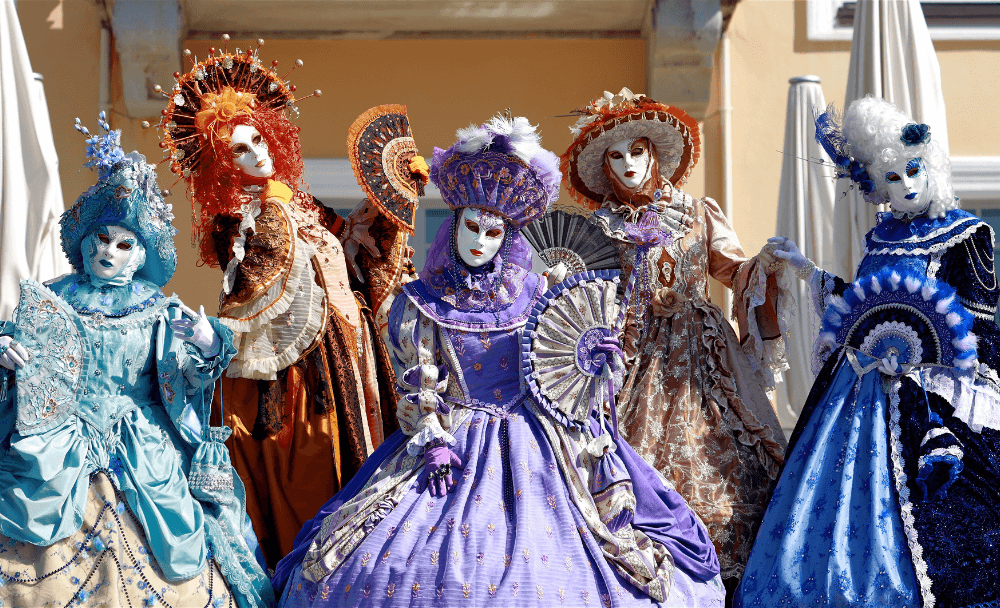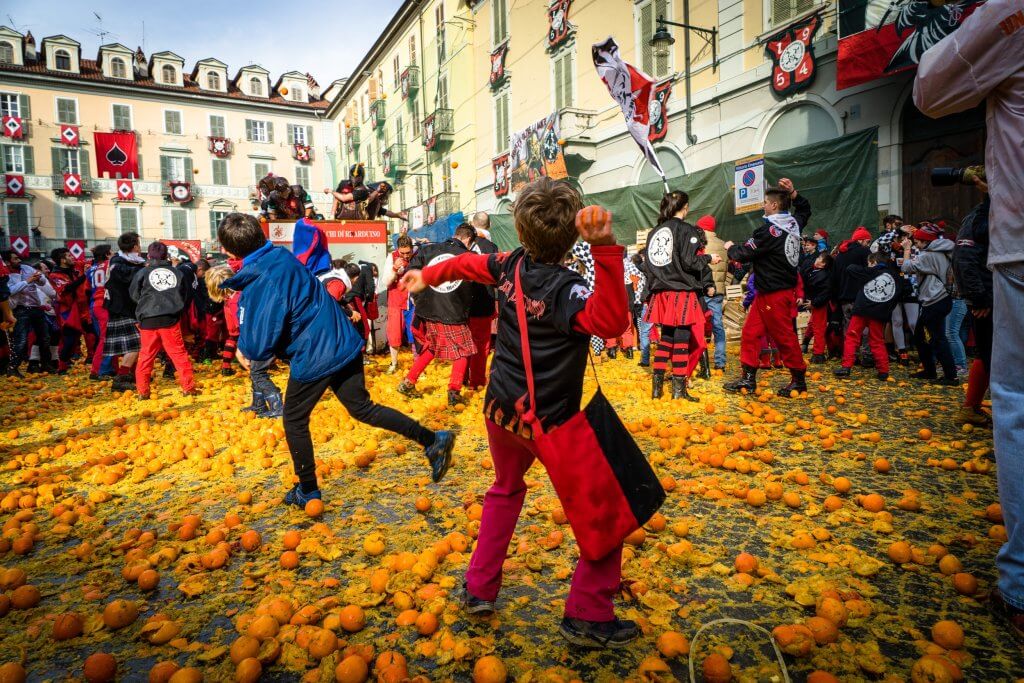Italian Mardi Gras, known locally as Carnevale, is a spectacular celebration that brings colour, excitement, and centuries-old traditions to life across the country. From the iconic masks of Venice to the funny orange battles of Ivrea, Italy’s Carnival season offers a unique blend of history, culture, and revelry that captivates millions of visitors from around the world each year. The vibrant and lively atmosphere of the celebrations spills into the city streets, where parades, traditional masks, floats, and performances animate urban spaces.

The roots of Italian Carnevale stretch back to ancient Roman times, with festivals like Saturnalia and Lupercalia serving as precursors to the modern-day celebrations. Saturnalia and Lupercalia were two of the most famous and important festivals in ancient Rome. Both had distinctive traditions and played significant roles in Roman religious and social life.
As Christianity spread throughout the Roman Empire, these pagan festivals were incorporated into the Christian calendar, giving birth to the term “Carnevale”.
Mardi Gras, or “Fat Tuesday”, marks the final day before Ash Wednesday, marking the beginning of Lent, a period of fasting and reflection leading up to Easter Sunday. This day of indulgence has evolved into a weeks-long celebration in many parts of Italy, with each region adding its own unique flair to the festivities. The Italian Carnival shares its vibrant celebrations and cultural importance with the Rio Carnival, both incorporating music, dance, and elaborate costumes as revelers indulge before Lent.

No discussion of Italian Carnevale would be complete without mentioning the elaborate masks and costumes that have become synonymous with the celebrations, particularly in Venice. The tradition of wearing masks in Venice dates back to the 13th century, when the Great Council first documented laws regarding their use. To prevent criminal activity, in 1339 a decree was issued prohibiting anyone from wearing false beards and wigs during Carnival, as these disguises allowed robbers and murderers to conceal their identities. Originally, masks served practical purposes:
Hiding their identity during illegal activities
Enabling social differences. to mix freely
Protecting doctors during plague outbreaks
Masks have been an important feature of the Venetian Carnival, with different styles worn by people of different occupations. The festival attracts approximately 3 million visitors annually and features a contest for the most beautiful mask.
Some of the most recognisable Venetian masks include:
Bauta: A white mask that covers the entire face, often worn with a black cloak and tricorn hat.
Medico della Peste: The iconic plague doctor mask with its long beak, originally designed to prevent the spread of disease.
Colombina: A half-mask that covers only the eyes and upper face, often adorned with gold, silver, and crystals.
Moretta or servetta muta: A small strapless black velvet oval mask with wide eyeholes and no lips or mouth.
These different masks, along with the intricate costumes that accompany them, transform Venice into a living work of art during Carnival.

While Venice’s Carnival is one of the most famous Carnival celebrations in the world, Mardi Gras celebrations can be found throughout Italy, each with its diverse array of unique and fascinating Carnival festivals. From the elaborate costumes and masks of the Venice Carnival to the colorful float parades of the Cento Carnival, there’s no shortage of exciting and unforgettable experiences to be had during the Carnival season in Italy.
Venice: The Venice Carnival features a contest for the most beautiful mask and a grand finale of fireworks and boat parades along the Grand Canal. Significant events, including mask parades and gondola processions, take place in Piazza San Marco, making it a vibrant hub of activity.
Viareggio: Known for its massive papier-mâché floats that satirise political and cultural figures, Viareggio’s float parade creates a vibrant atmosphere with colorful costumes, music, and festivities.
Florence: The Florence Carnival Parade is a vibrant expression of Florentine culture and history. With its blend of music, performance art, and community spirit, it offers an unforgettable experience for both locals and visitors alike.
Rome: At the Festa dei Moccoletti, participants carry lit candles or lanterns and try to extinguish each other’s flames.
Acireale: Boasts some of Italy’s most beautiful floats, adorned with fresh flowers.
Ivrea: Home to the famous “Battle of the Oranges” (Battaglia delle Arancie), where teams pelt each other with oranges in a good-natured fruit fight.
Putignano: One of the longest-running Carnivals in Italy, starting on Santo Stefano (26 December) and ending on Fat Tuesday (Shrove Tuesday).
Oristano Sa Sartiglia: Every year, the spectacular horse parade ‘Oristano Sa Sartiglia’ takes place in Oristano, Sardinia. This centuries-old tradition combines medieval splendour, exciting horsemanship and ancient rituals to create a unique festival in Italy.

No celebration would be complete without delicious food and drink, and Italian Carnevale is no exception. Traditional treats include:
Fritto misto: A mix of fried seafood and vegetables
Zeppole: Deep-fried dough balls dusted with powdered sugar
Frittelle: Sweet Venetian doughnuts
Galani: Thin, crispy cookies popular in Venice
To wash it all down, revellers enjoy vin brulé (mulled wine) and rich hot chocolate
One ticket that gives you access to all the top attractions, with no queues and at reduced prices

Whether you’re drawn to the mystery of Venice’s masked balls, the excitement of Ivrea’s orange battles, or the artistry of Viareggio’s floats, Italian Mardi Gras offers an unforgettable experience for travellers of all ages. It’s a chance to step back in time, immerse yourself in centuries-old traditions, and create memories that will last a lifetime. So why not add a touch of Italian magic to your travel plans?
Join the millions who flock to Italy each year to experience the wonder of Carnevale. From the moment you place your mask on until the last bite of zeppole, you will be immersed in a celebration like no other. Buon Carnevale!

Whether you’re drawn to the mystery of Venice’s masked balls, the excitement of Ivrea’s orange battles, or the artistry of Viareggio’s floats, Italian Mardi Gras offers an unforgettable experience for travellers of all ages. It’s a chance to step back in time, immerse yourself in centuries-old traditions, and create memories that will last a lifetime. So why not add a touch of Italian magic to your travel plans?
Join the millions who flock to Italy each year to experience the wonder of Carnevale. From the moment you place your mask on until the last bite of zeppole, you will be immersed in a celebration like no other. Buon Carnevale!